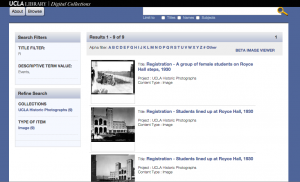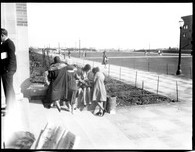The UCLA library digital collections features historic UCLA photographs taken between 1925 and 1964. The still images in themselves tell many stories, particularly of UCLA historic events depicting ceremonies, students, alumni, people of note, architectural inspirations, models of the earliest buildings and other artifacts relevant to the history of UCLA. Many of the photographs were taken by Thelner Hoover, the official photographer of many UCLA publications at the time. Each photograph’s meta data is visible to the user providing Title, Coverage, Date, Description, Format, Name, Relation, Type and several subject lines allowing multiple categorizations.
With all this information, a visual narrative can be constructed, as well as other very cool applications that provide historical information on demand. For example, using object recognition and augmented reality, a mobile application can be developed to provide users with a UCLA tour as they physically walk around the campus. They could us their phone to discover stories and photographs as the campus looked at different periods of its history.
If I were to write a paper on this archive, I could reconstruct many ceremonial dedications to opening buildings, tradition, ritual and cultural origins like the student registration on the Royce Hall steps dating back to 1930, and many other narratives speaking to UCLA student life. There are also many other topics of interst such as student diversity over time, fashion over time, gender over time, and many other socio-cultural aspects that the photographs depict.
 Because the archive is about our UCLA campus, many missing information about the photographs can, for the most part, easily be found on campus. Some other question may not be so easily answered about them. One example is reasons as to why photographs of certain events and not others were taken and perhaps the stories behind the less notable subjects in the pictures. The archive does not always provide clues to discerning this information from the pictures or metadata.
Because the archive is about our UCLA campus, many missing information about the photographs can, for the most part, easily be found on campus. Some other question may not be so easily answered about them. One example is reasons as to why photographs of certain events and not others were taken and perhaps the stories behind the less notable subjects in the pictures. The archive does not always provide clues to discerning this information from the pictures or metadata.
Nonetheless, something can be attempted to remedy this. Although not all the people in the photographs may still be alive or able to recall such details, an attempt to locate them and ask can be made. Interviews with these persons can provide some information to fill the information gaps and further enrich the context and narratives behind the photographs.
Archiving the official UCLA story tends to position the most distinguished events in the foreground, but discovering the context and narratives behind each would be more honest and interesting. Culture, gender, ethnic diversity, and other depictions are often times hidden both within and out of frame that could possibly tell a much more compelling story. What is not seen is often times just as important, if not more important, than what is. Associating these UCLA historic photographs with U.S. and world history would at the very least provide us with the ethos of the year depicted as in 1941 when the US entered one of the deadliest wars in human history.